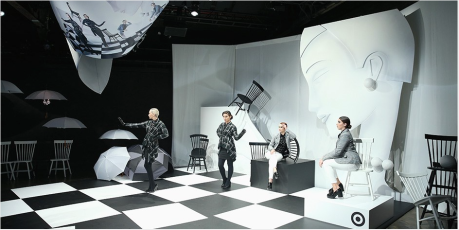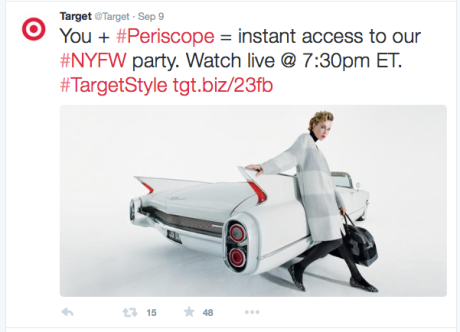
 Target is a master of consumer engagement through utilizing push and pull techniques. Although Target does have multiple campaigns running simultaneously to influence specific audiences, every media channel both on and offline are cohesive in creative and when seen together fit within the over-arching brand strategy seamlessly. In-store promotions have the same brand personality as ads, direct mail, weekly deals, website, Cartwheel App, A Bullseye View blog, digital ads and etc.
Target is a master of consumer engagement through utilizing push and pull techniques. Although Target does have multiple campaigns running simultaneously to influence specific audiences, every media channel both on and offline are cohesive in creative and when seen together fit within the over-arching brand strategy seamlessly. In-store promotions have the same brand personality as ads, direct mail, weekly deals, website, Cartwheel App, A Bullseye View blog, digital ads and etc.
Target’s offline push advertising consists of TV commercials, direct mailers, print ads, in-store signage (including floor decals, window clings, in-store displays and digital hyper-walls) all aimed at influencing the consumer to purchase. All of their traditional media pushes consumers online to the website, Cartwheel app or in-store to purchase or to retrieve special offers. They also offer in-store service pushes like the Beauty Concierge and Baby Advisor services where knowledge staff members help customers with buying decisions.
A new print push technique Target debuted uses Shazam to add augmented reality to print ads running in Vogue magazine. By scanning the page with the Shazam app, pull strategies launch on your iPad or smart phone such as behind the scenes video, photos, special click to buy deals and blog posts. This particular campaign featured Target fashion highlighting New York Fashion Week (#NYFW) and was even meshed with the “It’s a Plaid, Plaid, World” campaign. (The #NYFW and “It’s a Plaid, Plaid World campaigns were also featured on Target’s Facebook, Twitter, Pinterest and Instagram accounts.)
When you hover over the Vogue print ads with your phone or iPad, video pops up to augment the content. Here are some examples:
The company uses online push advertising with the Cartwheel app, e-newsletters and Target account email e-blasts and CSR pop up windows to name a few.
For Target’s pull marketing, they add to the consumer experience with fresh content of the A BullsEye View blog, user product reviews, Behind the Pin video DIY help guides, custom shopping lists, Blog e-newsletter, behind the scenes YouTube video, look books. Their social media channels include links as well to improve the user experience and share-ability.

As seen on Target’s Twitter feed. #NYFW party on Periscope again featuring #NYFW and “It’s a Plaid, Plaid World” campaigns.
Throughout Target’s website and Cartwheel mobile app are opportunities to not only follow the company’s social media channels, but also share to your own social media accounts.
In my opinion, Target does a pretty great job of utilizing many push/pull techniques in their touch points. Frankly, I’m surprised how well they do considering how many touch points and services the have. But Target’s goal of increasing the shopping experience is hard to miss. One recommendation would be for users to add images and video along with the online reviews, but that would entail extra monitoring by Target and could have potential problems. Amazon uses a similar technique in their customer review sections and has increased the online shopping experience. Another pull strategy could be to allow online groups, again like Amazon does, so you can connect to other consumers with the same hobbies and shopping likes.
In September 2015 Target launched LA25. A pilot program where they are building test stores to launch new programs, services and digital products to increase the consumers shopping experiences with the end goal to increase sales. Maybe after Target does some more in-store and digital testing we will see even more improvements for the consumer while increasing profits.
Source links:
http://www.digitaltrends.com/mobile/shazam-digital-recognition-new-target-ads/
http://www.vogue.com/TargetStyleMarketing/target_desktop/index.php
https://corporate.target.com/article/2015/08/plaid-fall-look-book
http://nymag.com/thecut/2015/06/adam-lippes-is-the-latest-target-collaborator.html
http://nymag.com/thecut/2015/08/targets-fall-collaboration-is-full-of-plaid.html#
https://corporate.target.com/Carousels/2015/08/Plaid-Lookbook
https://corporate.target.com/article/2015/09/la25-announcement
































